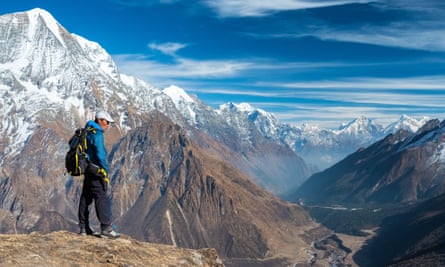Independent trekking is about to be banned from Nepal’s protected mountain regions and national parks, in a move designed to boost employment and increase safety for tourists visiting the country’s Himalayan range.
From April all foreign trekkers, whether solo or in a group, must be accompanied by a licensed guide. The announcement was made by the Nepal Tourism Board (NTB) in early March, and applies to cyclists as well as hikers.
Visitors will need to source their guides though trekking agencies registered with Taan (Trekking Agencies Association of Nepal), a group representing more than 2,000 government-approved trekking and mountaineering guiding companies.
The NTB hopes this will improve the safety of visitors, while helping Nepal’s tourism economy. “In addition to safety, the new system will create employment for workers in the tourism sector of Nepal and discourage unauthorised trekking operations in the country,” it said.

Trekkers will also need to obtain, through their trekking company, a TIMS card (Trekkers’ Information Management System), which will work like a permit. The price of the card will be 2,000 Nepalese rupees (£12.50) for most international visitors – previously, it was 1,000NPL for those on group treks.
Nepal’s natural infrastructure, with trails linking villages and guesthouses among the highest peaks on Earth, makes it the adventure capital of the world, with tens of thousands of adventurers hitting the trails each year. In 2019 more than 171,000 visitors went trekking in the country, with 27% (46,000) of them deciding not to hire a guide or porter, according to the NTB. With the post-pandemic tourism industry still in recovery, more than 19,000 people trekked unguided in 2022.
Altitude illnesses, getting lost, extreme cold, and whiteouts are potential hazards for high-altitude trekkers. In the lowlands, climate change is bringing an increasingly extreme monsoon season, which is triggering more landslides, according to research by the University of Plymouth. This is having a shapeshifting effect on the trails, making navigating a safe route increasingly difficult in some areas, such as the Annapurna region.
The NTB has quoted the annual fatality number of trekkers as 10-15 a year. The figures may be lower, according to missingtrekker.com, a website that tracks reports of missing and deceased trekkers in the mountains. It recorded five fatalities in 2022, two in 2019, and three confirmed cases in 2018, but seven unconfirmed. There are no figures for 2020-21. There were five in both 2016 and 2017.
after newsletter promotion

Ed Douglas, author of Himalaya: A Human History and co-editor of the Alpine Journal,said the move by Nepal’s tourism ministry was part of a pattern that had steadily increased bureaucracy and costs for trekkers and mountaineers.
“Trekking agents will be very pleased, because it’s more business for them, but forcing tourists to behave in a certain way will put some people off,” he said. “It also remains to be seen whether it will make trekking safer. They haven’t managed it yet with aviation. And I question whether Nepal has enough qualified trekking guides to meet demand.”
Sudeep Kandel, owner of tour operator Himalayan Adventure Labs, said there had been a lack of proper consultation and planning from the country’s tourism bodies. His company is in the process of launching the Himalayan Trekking Safety Initiative, which will be available to all guides for a nominal fee, providing satellite phones and trackers, medical insurance and search-and-rescue coverage for trekking guides.
“There needs to be a detailed plan on how this will be implemented and what the repercussions will be if one does not follow the rule. While the rule has good intentions of ensuring the safety of trekkers, it may not be the right instrument for doing so,” he added.The spring trekking season is already in full swing, with tourism usually peaking in April. For those who head into the mountains after 1 April, the cost of hiring a guide is estimated to be around £20-40 a day, for package tours or technical routes. Trekking unguided outside the mountain conservation areas and in national parks is still allowed.
 Top Naija News: Nigerian News, Breaking News Nigeria and World News Top Naija News is a daily news publication in Nigeria, delivering the latest breaking news in Nigeria and around the world.
Top Naija News: Nigerian News, Breaking News Nigeria and World News Top Naija News is a daily news publication in Nigeria, delivering the latest breaking news in Nigeria and around the world.



